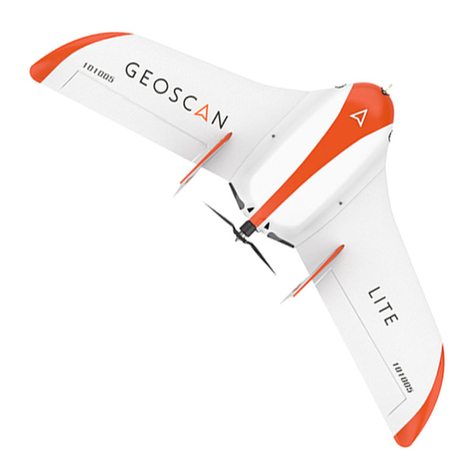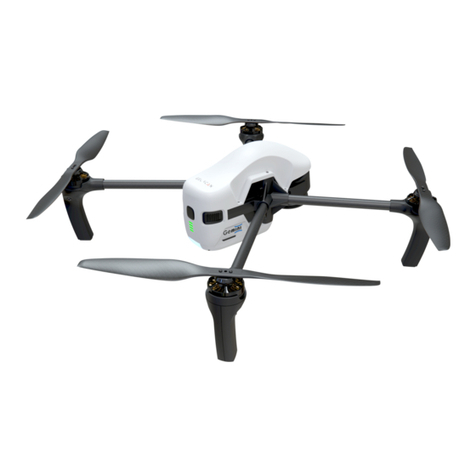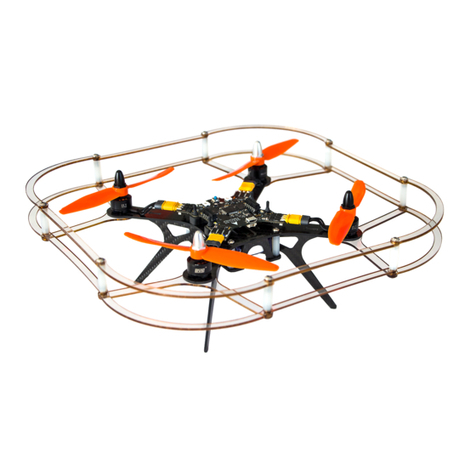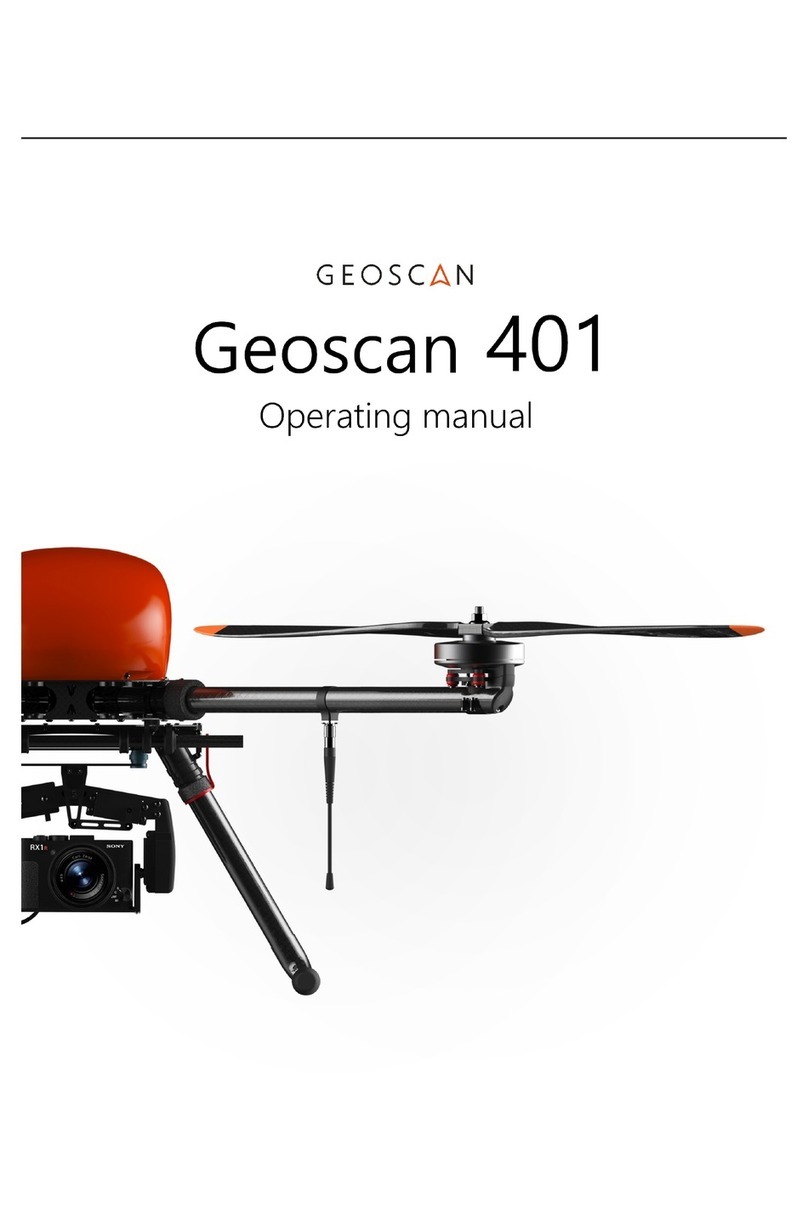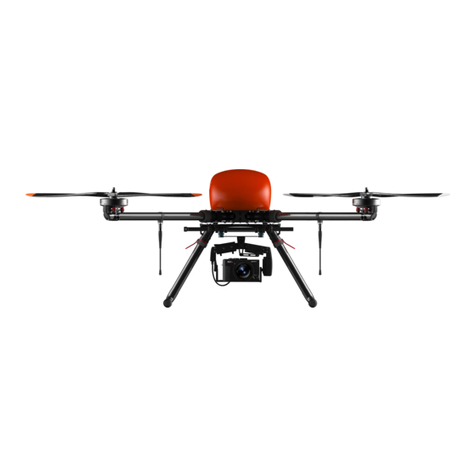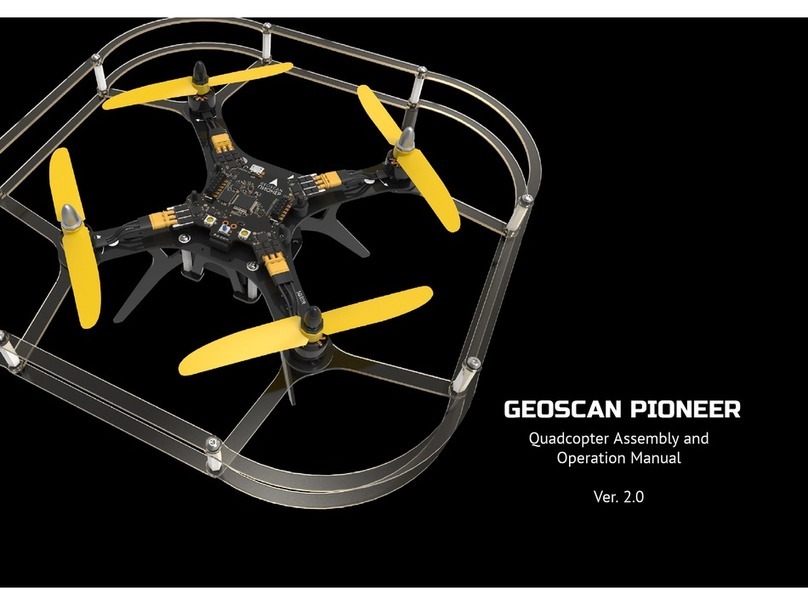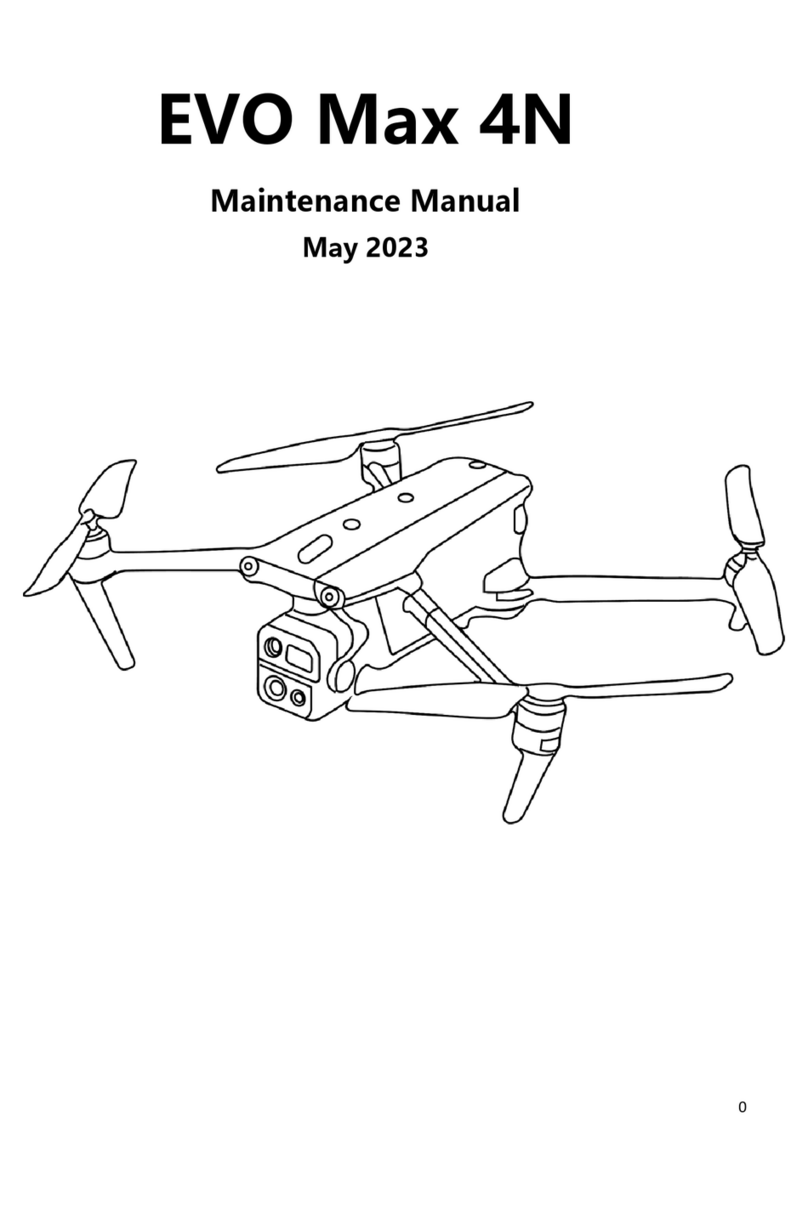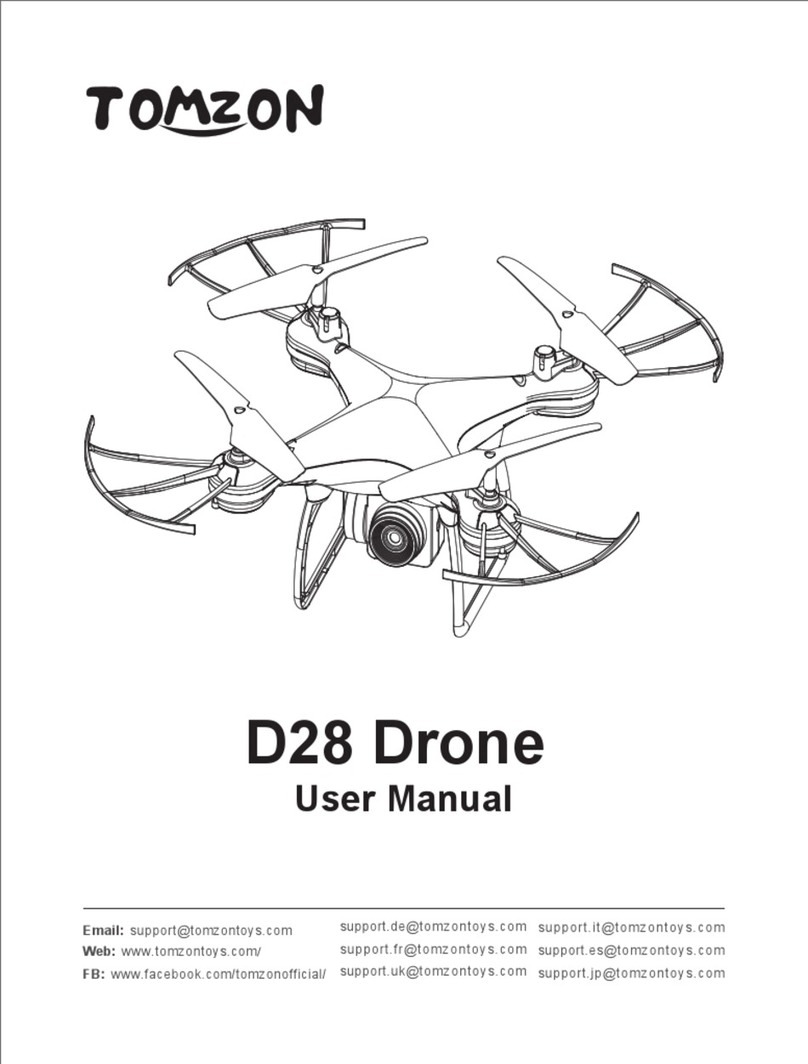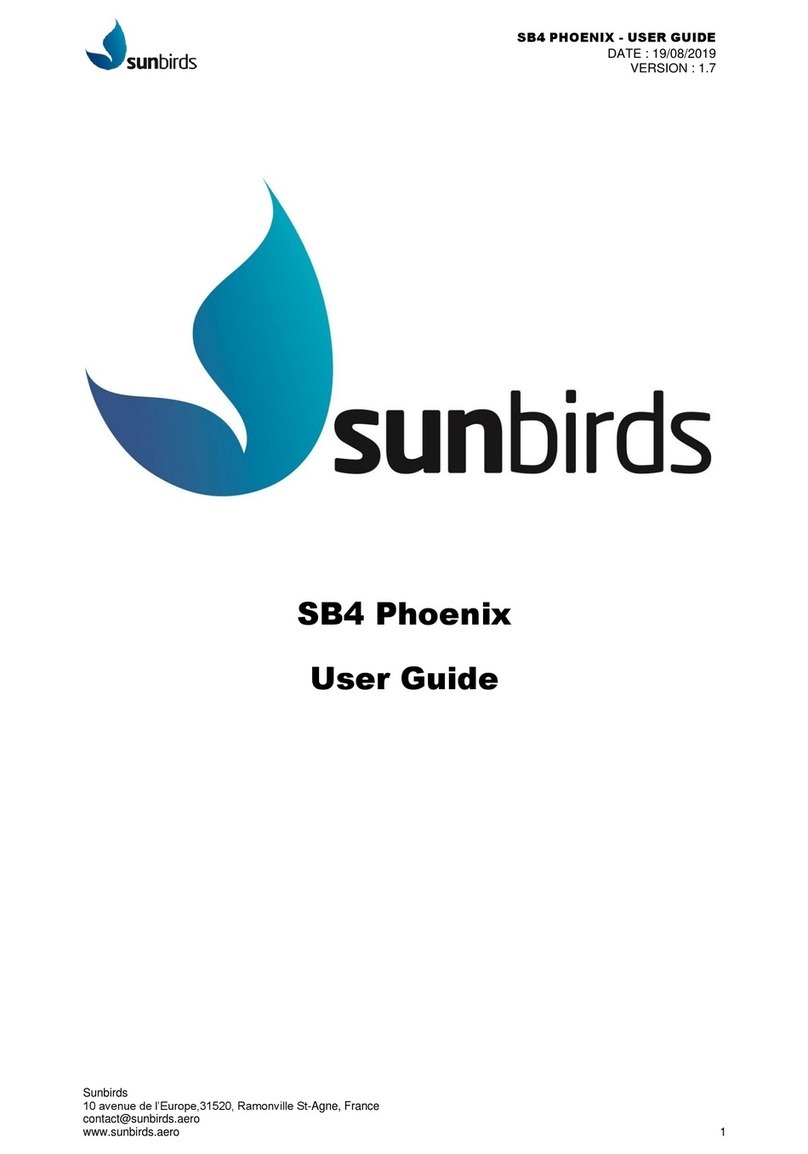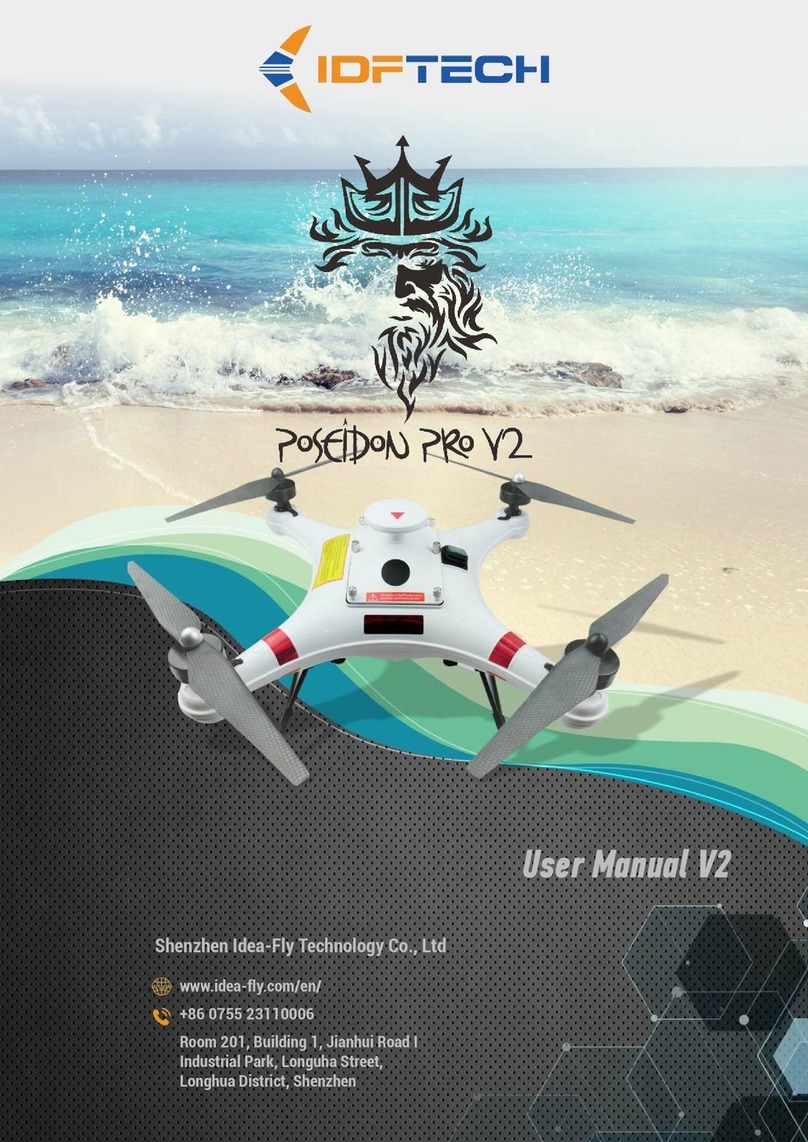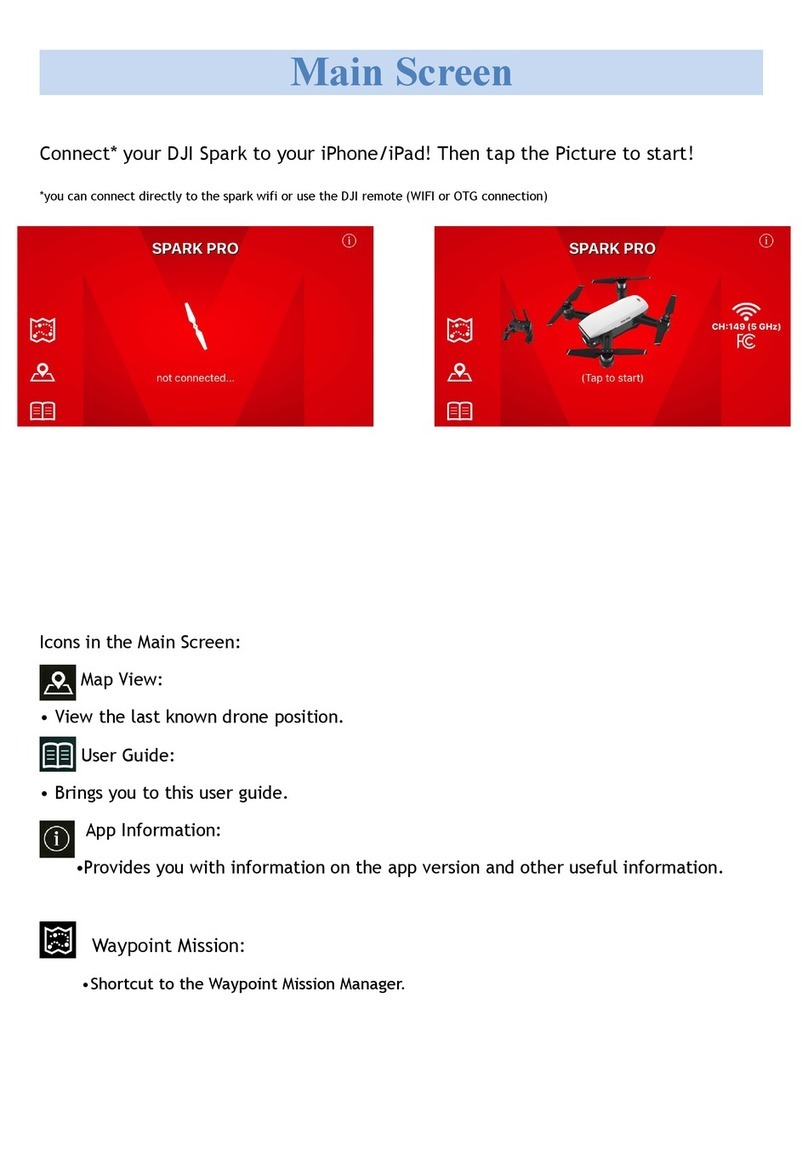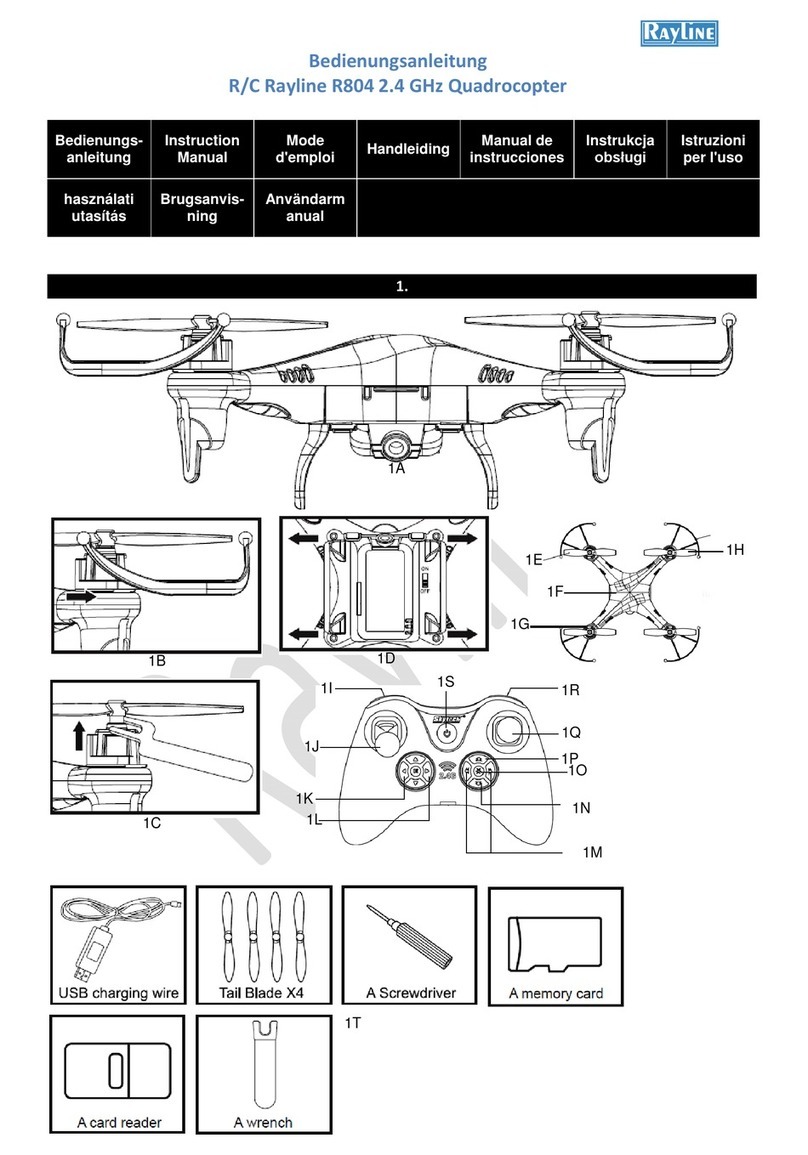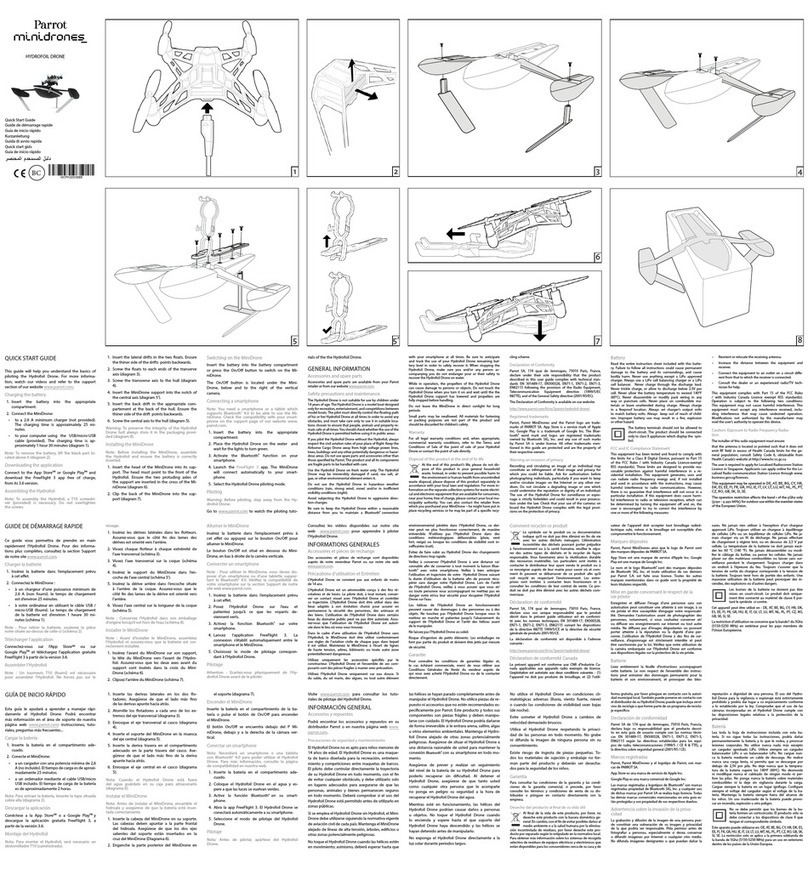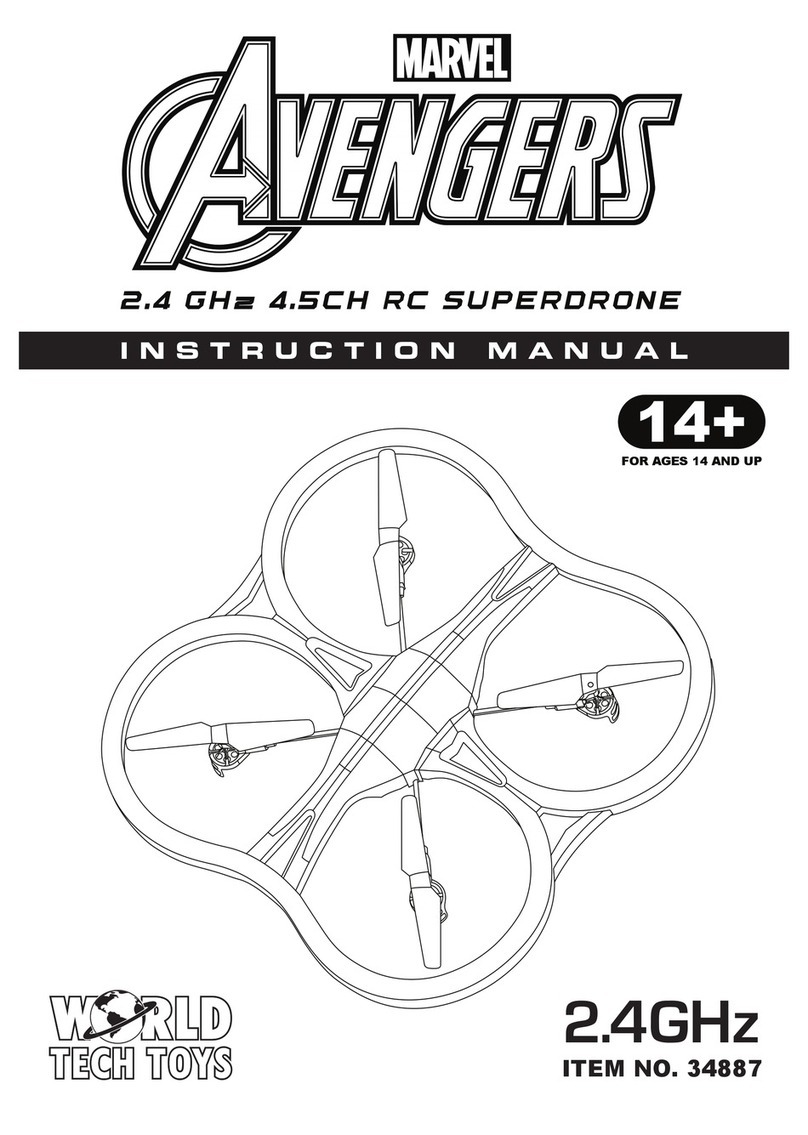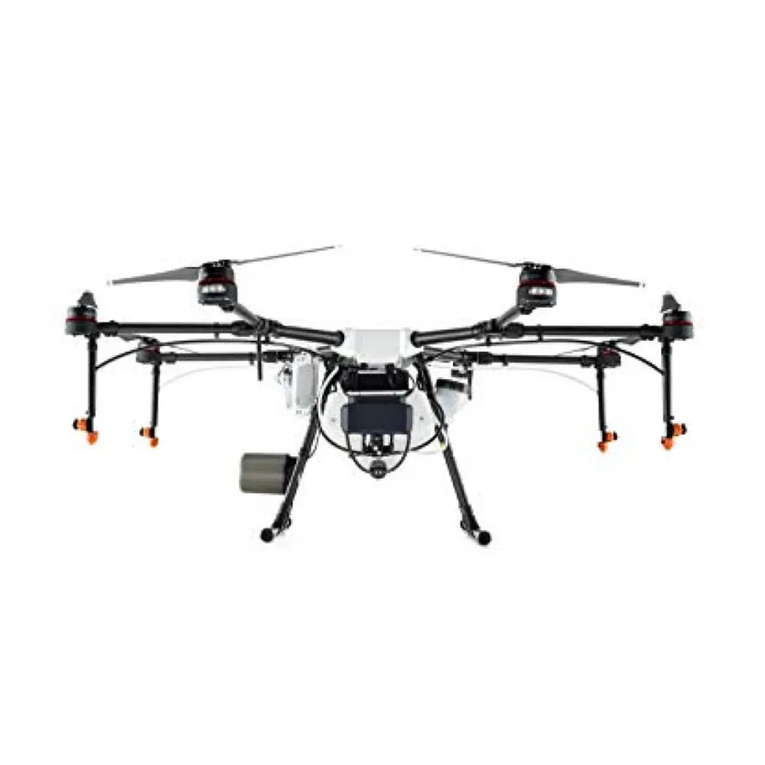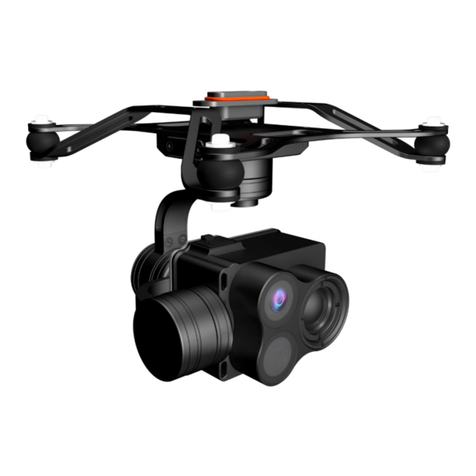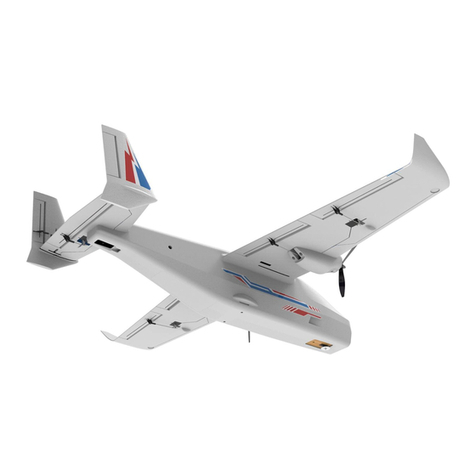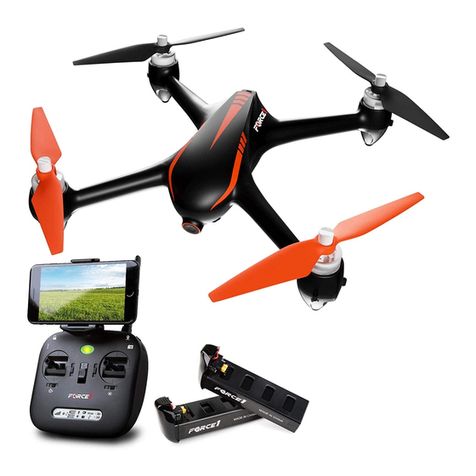Geoscan 401 User manual

Geoscan 401
User Manual
Updated on November 12, 2021

Contents
Introduction 4
Abbreviations 5
Main Information 6
Kit................................................ 7
MaintenanceService..................................... 9
Storage............................................. 9
Safety Rules 10
Assembly 12
Charger and Battery 18
SafetyRules.......................................... 18
ChargerPreset ........................................ 19
Battery Indication and Control . . . . . . . . . . . . . . . . . . . . . . . . . . . . . . . 20
Battery Connecting to The Charger . . . . . . . . . . . . . . . . . . . . . . . . . . . . 23
Battery Heating (for «Arctic» battery) . . . . . . . . . . . . . . . . . . . . . . . . . . . 23
Storage and Discharge . . . . . . . . . . . . . . . . . . . . . . . . . . . . . . . . . . . 24
BatteryRecycling....................................... 24
Payloads 25
Sony DSC-RX1RM2 Digital Camera . . . . . . . . . . . . . . . . . . . . . . . . . . . . 25
MainParts ....................................... 25
Presets.......................................... 26
PresetsRestoring ................................... 27
SDCardFormatting.................................. 28
SettingsReset ..................................... 29
CameraOffsets..................................... 30
Sony DSC-RX1 Digital Camera . . . . . . . . . . . . . . . . . . . . . . . . . . . . . . . 31
MainParts ....................................... 31
CameraSettings.................................... 31
2

SDCardFormatting.................................. 33
SettingsReset ..................................... 33
CameraOffsets..................................... 34
Sony A6000 Digital Camera . . . . . . . . . . . . . . . . . . . . . . . . . . . . . . . . 35
MainParts ....................................... 35
CameraSettings.................................... 35
SDcardFormatting.................................. 36
Geoscan Planner Software 37
System Requirements . . . . . . . . . . . . . . . . . . . . . . . . . . . . . . . . . . . . 37
NewProject.......................................... 38
AerialSurveying.................................... 39
Adding and Removing of Polygon Vertexes . . . . . . . . . . . . . . . 39
Change Flight Route Direction . . . . . . . . . . . . . . . . . . . . . . . 40
Start Point Changing . . . . . . . . . . . . . . . . . . . . . . . . . . . . . 42
LinearSurveying.................................... 43
FlightByPoints................................ 44
WaitingPoint...................................... 45
LandingPoint ..................................... 46
Radio Modem Connection . . . . . . . . . . . . . . . . . . . . . . . . . . . . . . 47
Connecting UAV to Geoscan Planner . . . . . . . . . . . . . . . . . . . . . . . . 49
LaunchPreparing....................................... 50
Flight.............................................. 51
Canceltool .......................................... 52
ImmediateLanding ..................................... 52
GuidedFlight......................................... 53
Semi-automatic Remote Control . . . . . . . . . . . . . . . . . . . . . . . . . . . . . . 54
Launch 55
UAV Disassembly 56
Appendix 57
Specications......................................... 57
3

Introduction
Thank you for choosing Geoscan 401 UAV!
This manual is designed to describe UAV structure and the operating rules. We highly
recommend to read the manual carefully before using UAV.
If you have any questions about UAV, technical service and repair, please contact our sup-
port: https:// www.geoscan.aero/ en/ support.
We always glad to help you and answer any questions about product.
The information, specications and pictures in this manual are relevant at the time of
publication. Geoscan Group may change the UAV design or specications without prior
notice.
Do not make any changes to UAV structure by yourself. Any UAV damages or degraded
specications caused by structure changes are not covered by the warranty.
We always work to make our products better and add new features. You can always down-
load the newest version of this manual from our website:
https:// www.geoscan.aero/ ru/ products/ 401
This mark highlights important information and recommendations. It is nec-
essary to follow these instructions for people and UAV safety.
4

Abbreviations
CPS Count Per Second
GNSS Global Navigation Satellite System
UAV Unmanned Aerial Vehicle
USB Universal Serial Bus
5

Main Information
Geoscan 401 is multifuctional unmanned aerial system that included quardcopter drone
with сhangeable payload and ight mission planning software.
Drone application depends on installed payload. The system can be used for aerial sur-
veying, laser scanning, measuring of gamma-spectrum values, magnetic or multispectral
surveying.
6

Kit
Geoscan 401 UAV
Quadcopter Frame of landing gears
Landing gear — 2 pcs. Propellers (pair) — 2 pcs.
Battery UAV antenna
Radio modem SD card
USB Cable USB ash drive
Battery charger in case UAV transport case
Documentation
7

Payloads *
Digital camera Multispectral camera
Gamma-ray spectrometer Lidar
Quantum magnetometer
* — payload type depends on delivery kit
8

Maintenance Service
Visually inspect UAV for a damage after each ight.
If the propellers are damaged, you can replace them by yourself using spare parts from
the kit.
If airframe or system damages are detected, please contact support.
After 80 ights we recommended to send UAV to the manufacturer for inspection and
maintenance.
Storage
Geoscan 401 UAV (without the battery) should be stored in a transport case in dry room
at temperature range from +5 to +25 °C and relative humidity not more than 85% without
condensation.
Service life (without the battery) — 2 years.
Batteries should be stored in a cool and dry place without direct sunlight, at a temperature
of +5 to +25 °C and a relative humidity of 80% without condensation.
Optimum temperature range from +5 to 10 °С.
Optimal charge level for a storage: 38.5 V (see Battery and Charger section for details).
Battery service life — 1 year.
9

Safety Rules
Follow these operating instructions for UAV safe use:
• UAV launch and maintainence can be held only by persons who trained according to “The
plan of theoretical and practical training for the operator of GEOSCAN 401 unmanned aerial
system”.
• Follow dealer’s and/or manufacturer’s recommendations and instructions for use of the
equipment, as given in this manual and received during operation period.
• Carefully inspect ight area before ight and make sure that a ight path passes not less
than 100 m above the terrain and high-rise objects (mountains, towers, pipes, transmission
towers, etc.).
• DO NOT launch the UAV, if any damage is detected.
• DO NOT allow unauthorized persons into the UAV launch area.
• DO NOT launch or y UAV near high power radio transmitters.
• AVOID ying above crowded places.
• DO NOT assemble or disassemble the UAV when the power is on.
• DO NOT short circuit the battery.
• transport UAV and equipment in transport case only.
• Hold assembled UAV by quadcopter’s frame arms, when you move it.
• DO NOT make any changes in UAV construction.
10

Operational Restrictions
• Operating temperature range without payload: from -20 to +40 °С.
-40 to +20 °С for «Arctic» battery.
• The operating temperature ranges of the payloads and other operating limits are
listed in Appendix section.
• Max wind speed: 12 m/s.
• The aerial survey system is not designed to y during rain, snow or other precipita-
tion.
• UAV should be left at room temperature for 24 hours after transporting at sub-zero
temperatures.
11

Assembly
1. Take the landing gears’ base part and landing gears from transport case.
2. Put landing gears in tubes of base part.
3. Rotate landing gears’ nuts to attach them to base part and lock elastic locks.
Landing gears installing
4. Take the quadcopter from transport case.
5. Remove protective transport elements.
6. Take quadcopter’s frame arms out to the sides.
Quadcopter assembly
12

7. Move frame arms’ nuts to the quadcopter’s frame central part and lock it.
Lock by nuts
Make sure that the nuts are covered frame pins.
8. Place the quadcopter on landing gears’ base part.
Frame loops must be connected with landing gear’s loops.
9. Take payload cradle and position it under the quadcopter’s frame. The frame loops must
be connected with cradle’s loops. (see the picture).
The camera lens should be directed in the direction of the slope of the quadcopter fairing
for camera only payloads.
Lidar payload position: place scanning cylinder in forward direction.
Gamma-spectrometer position: place scanning cylinder in rearward direction.
Example of camera payload installing
13

10. Put mounting rods in loops.
Mounting rods installing
Make sure that the rods are inserted as far as possible (the rings on the rods
should be pushed to loops’ red seals).
11. Attach the propellers to UAV motors.
Color marks on the propellers and motors should be in same color.
Icons on the propellers shows rotating direction for attaching.
Hold motor cover and screw each propeller.
Rotate propellers in oposite direction to deattach them.
Propellers installing
Make sure that the propellers are not damaged before each start. The pro-
pellers should be free from a dirt and any stickers. Do not use cracked or
damaged propellers.
14

12. Connect payload power cable (if your payload needs power from UAV battery) to UAV
slot.
Connect GNSS antenna cable to UAV for payloads with in-built GNSS receiver.
Lidar connecting with 2 cables example
13. Screw UAV antenna to UAV arm.
UAV antenna connecting
Make sure that the port and connector are clean. Clean it with an alcohol-
moistened lint-free cloth, if it needs.
Do not turn UAV power on without antenna. It can damage in-built UAV re-
ceiver.
15

14. Eject SD card (-s) from payload and UAV in-built GNSS receiver (availability depends
on UAV conguration), format and place in slots.
Installing SD card in GNSS receiver slot (availability depends on UAV conguration)
15. Turn UAV battery on by press control button
16. Eject the battery in UAV slot connecting pins should be on the left side.
Battery installing
16

16. Secure the battery by spring-loaded stops.
Press on spring-loaded parts and put it in battery slots.
On earlest Geoscan 401 UAVs the battery is secured by a velcro.
Battery securing by spring-loaded stops
17

Charger and Battery
Safety Rules
Battery
• DO NOT disassemble or deform the battery (do not drop and pierce).
• DO NOT allow heat the battery more than 60°С.
• DO NOT overcharge the battery (over 42 V).
• DO NOT allow the battery discharge below 30 V.
• DO NOT store fully discharged batteries. Change battery mode to Storage for a long
storage (more than month)
• DO NOT charge battery by currents more than charge limit (no more than 100% of
the capacity. We recommended to charge 50% of the capacity to extend the battery’s
life cycle). Current more than the limit will overheat the battery.
• Store the battery in warm place before ight at a temperatures below 0°C. When you
create ight project, keep in mind the fact that LiPo batteries can lose up to 30% of
capacity in cold conditions.
• Store the battery at the temperatures +5 to +20 °C without direct sunlight before
ight at a temperatures more than +25°C.
• Do not charge the battery directly before ight. Wait for a battery cooldown. Charge
the battery in the cool place without direct sunlight.
• Ignoring these instructions may result battery failture and re.
Battery Charger
• Turn on charger before connecting the battery.
• Check cables for a damage before use. Do not use damaged cables and connectors.
• DO NOT use the battery charger under direct sunlight.
• DO NOT use the battery charger without supervision.
18

Charger Preset
The charger is congured from the factory.
Follow the instructions to cong preset, if the settings are different.
To open settings:
• On PROGRAM SELECT main screen press Batt type/Stop button several times, to the
moment, when screen will Settings section.
Settings section
• Press Start/Enter to open settings menu.
Use Dec and Inc buttons to choose parameters and Start/Enter to select.
• Select Safety timer and press Start/Enter button.
Use Dec/Inc buttons to change it to OFF. Press Start/Enter button until stop switcher
blinking.
Safety timer — off
Press Batt type/Stop button to exit in Settings nenu.
• Select Capacity cut-off and press Start/Enter button.
Use Dec/Inc buttons to change it to OFF. Press Start/Enter button until stop switcher
blinking.
Press Batt type/Stop button to exit from settings section.
Capacity cut-off — off
• On PROGRAM SELECT main screen select Lithium battery section and press Start/En-
ter button.
19

Lithium battery section
Set these parameters:
AUTO value select battery cells number (S) automatically.
Charge current: 8,0 A.
Other settings should be default.
Battery Indication and Control
Battery LEDs and buttons
1. Control button 4. LED indication bar
2. Indication LED 5. Balance connector slot
3. Heat indication LED («Arctic» battery) 6. Connect and charge pins
Press the button (1) to check battery status.
Green LED indication bar (4) shows battery charge level. LED indication bar change color
to red and show temperature inside the battery (see the table for degrees description),
Green color of voltage LED (2) means that LED indication bar shows battery voltage (The
battery is fully discharged, when the LED ingicators (4) are off. All LED indicators are
20
Other manuals for 401
2
Table of contents
Other Geoscan Drone manuals
